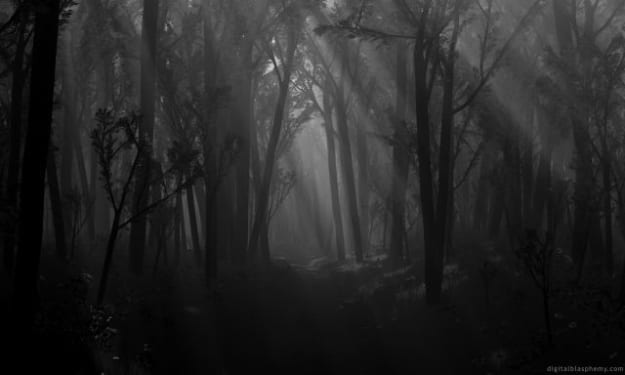Varney the Vampire; or, the Feast of Blood
For every story out there, for every monster, there are tropes. It happens with them all, but somewhere, there's a beginning. A place where the tropes start, a story where we can point our finger and say, "that right there is where vampires first got their fangs!" That's Varney the Vampire. The origin of fictional vampires with fangs. And that's not all.

"The figure turns half round, and the light falls upon its face. It is perfectly white — perfectly bloodless. The eyes look like polished tin; the lips are drawn back, and the principal feature next to those dreadful eyes is the teeth — the fearful looking teeth — projecting like those of some wild animal, hideously, glaringly white, and fang-like. It approaches the bed with a strange, gliding movement. It clashes together the long nails that literally appear to hang from the finger ends. No sound comes from its lips. Is she going mad — that young and beautiful girl exposed to so much terror? she has drawn up all her limbs; she cannot even now say help. The power of articulation is gone, but the power of movement has returned to her; she can draw herself slowly along to the other side of the bed from that towards which the hideous appearance is coming."
— From Chapter I of Varney the Vampire; or, the Feast of Blood
I've got about 250 items on my list of Into Horror History writing ideas at the moment. It's constantly growing. I actually don't have a lot of vampire fiction on there right now because I haven't fleshed out that topic yet. To pick a weekly topic to write about for my newsletter, I just pop open a random number generator and use the first thing it chooses for me. I recently wrote about Carmilla by Sheridan Le Fanu—a vampire story featuring a female vampire and a strong young woman. It appeared in the penny dreadfuls back in 1872.
To my surprise and delight, I rolled a random number this week, and it landed on another vampire piece from the penny dreadfuls: Varney the Vampire. It was published as a weekly serial from 1845 to 1847, nearly thirty years before Carmilla, which just goes to show that Victorian-era people loved their vampire serials.

The Tropes Before They Were Tropes
Everything we've come to know and recognize as a typical vampire started somewhere. There's a word to describe those recognizable things in literature (and film): trope. I've introduced a few friends to the term, and you already know it, but if you don't, here it is:
trope: any type of figure of speech, theme, image, character, or plot element that is used many times.
Tropes aren’t necessarily bad, as they help a reader (or viewer) readily identify something happening in a story. A great example from science fiction is the “space is an ocean” trope that many science fiction stories set in space use create a world that is easier to digest. Spaceships, star fleets, docks, ports, solar sails, captains and admirals, habitable planets are scattered like islands, spaceships have a top and bottom, space whales, space clouds you can hide in like a fog, and the list just goes on.
Horror is no different and has plenty of tropes of its own: a small town with a dark secret, zombie apocalypse, supernatural stuff is green, flashlights die, Indian burial grounds, cannibalistic hillbillies, fire kills evil, gypsy curses, final girls, Ouija boards are evil, haunted dolls, evil circus, ancient evils, and, of course, the concept of evil itself. There are dozens, possibly hundreds, maybe more, and that’s just the generic ones that span across the entire genre.
You may have noticed already that the line between trope and cliché is a bit fuzzy at times. For every story out there, for every monster, there are tropes. It happens with them all, but somewhere, there’s a beginning. A place where the tropes start, a story where we can point our finger and say, “that right there is where vampires first got their fangs!”

That’s Varney the Vampire. The origin of fictional vampires with fangs. And that’s not all; here’s a shortlist of other incredibly now recognizable vampire tropes that started with Varney:
- Leaves two puncture wounds on the necks of victims
- Hypnotic powers
- Superhuman strength
- The sympathetic vampire that hates being the way that he is but is a slave to it
- The “hunger”
- Going feral if a long time passes without feeding
Interestingly, there are also a few vampire rules set forth in Varney that weren’t carried forward (for the most part), like Varney is a daywalker (sunlight has no negative effect), and he’s healed by moonlight. There’s another trope in Varney the Vampire that I couldn’t verify whether or not Varney started it: Varney resembles an ancestral portrait.

Missing Tropes
Garlic and crosses have no effect, so that trope invention came later. Vampires loathing garlic may have roots in rabies since infected people are hypersensitive to olfactory stimulation. Having no reflection in mirrors indeed did come later, from Bram Stoker's Dracula.
"No, no – we will not be terrified thus – there is Heaven above us."
— Varney the Vampire
The Author(s)
No one really knows who wrote Varney the Vampire. It was published by a man named Edward Lloyd, who became well-known for his penny dreadful serials and then later moved into the newspaper business. Edward Lloyd didn't allow authors to put their names onto published works, thus the mystery of who exactly penned Varney the Vampire.
"Although an American would always rather lose a drop of blood than a dollar, they keep a pretty sharp look out upon both."
― Varney the Vampire
Lloyd mainly employed freelancers, purchasing their works by the line or page. Two of his most frequently used authors are thought to have written Varney the Vampire: James Malcolm Rymer and Thomas Peckett Prest.
Must have a quid for my quo, as the parsons say.
― Varney the Vampire
Unfortunately, not much is known about either of these two, except that they perhaps co-authored several works, including The String of Pearls, where "the Demon Barber of Fleet Street," Sweeney Todd, makes his debut. In fact, if you try to look up either of them, you're likely to find a photo of Edward Lloyd being used as both James and Thomas in various places around the Internet. So it goes.

Both James Malcolm Rymer and Thomas Peckett Prest wrote under many pseudonyms, and of course, with no attribution in the penny dreadfuls, so accurately tracking their works is pretty much impossible.
Penny Dreadfuls
I always thought "penny dreadful" was an excellent name for horror serials, but the term is actually pejorative, and modernly you might call them something more like "penny awful" to adequately capture the meaning. They weren't exactly considered the pinnacle of literature in their time; however, they were incredibly popular, selling over a million periodicals per week at their height.
The world, my good sir, is censorious, and you cannot stop people from saying extremely ill-natured things.
— Varney the Vampire
There's a good article at The Guardian about the public's response to penny dreadfuls during their popularity: Penny dreadfuls: the Victorian equivalent of video games. For the most part, the penny dreadfuls targeted young working-class men and, much like today, were blamed for everything from eroding civility all the way to violence and murder.

Vampires Before & After Varney
Even though the idea of vampires has been around for thousands of years, spanning across ancient cultures that had no contact with one another, fictional vampires didn't take off until about the 1920s with films.
A few pieces of vampire fiction predate the 1845 release of the first Varney the Vampire serial, but there aren't many that we know of currently. A German poem in 1748 titled The Vampire by Heinrich August Ossenfelder and another poem titled Lenore from 1773 by Gottfried August Bürger are two notable ones, along with a handful of others on my list to write about in the future.
Vampiric folklore goes as far back as Ancient Egypt, with a deity known as Sekhmet, who drank human blood, pomegranate juice, or blood-colored water—depending on who you listen to. Or, perhaps Lilitu from Ancient Babylonia. A few other stories from the Ancient World (some with a questionable origin) resemble early vampires, even though the term for them didn't exist.
Whatever their origin, you can bet that they'll continue to be around for as long as us humans—we are their food, after all.
Where to Read Varney the Vampire
It's fascinating to go back into horror history and discover early works or roots of what are now well-known monsters. For Varney the Vampire, if you go into it with knowledge of what those old periodicals were, then you'll find a mostly pointless story that spans about 900 pages—but it's a fun and entertaining read—precisely the purpose of the old Victorian penny dreadfuls. They had a massive impact on future works, and it's hard to imagine a world where the tried and true vampire tropes don't exist.

You can read it online at Varney the Vampire; Or, the Feast of Blood by Prest and Rymer on Project Gutenberg.
There was also a two-volume version published in 2015 by Dover Horror Classics that features woodcut illustrations, notes about the work, and an introduction by E. F. Bleiler.
- Varney the Vampyre: or, The Feast of Blood, Part 1
- Varney the Vampyre; or, The Feast of Blood, Part 2
It's also freely available on LibriVox in audio format.
Also, an indie filmmaker named John Faust put his 28-episode web series, Varney the Vampire (Or, The Feast of Blood), up on YouTube for free.
Read about another penny dreadful post of mine: Carmilla by Sheridan Le Fanu
~
Originally published in my weekly newsletter Into Horror History — every week I explore the history and lore of horror, from influential creators to obscure events. Cryptids, ghosts, folklore, books, music, movies, strange phenomena, urban legends, psychology, and creepy mysteries.
About the Creator
J.A. Hernandez
J.A. Hernandez enjoys horror, playing with cats, and hiding indoors away from the sun. Also, books. So many books—you wouldn't believe.
He runs a weekly newsletter called Into Horror History and writes fiction.
https://www.jahernandez.com
Reader insights
Outstanding
Excellent work. Looking forward to reading more!
Top insights
Easy to read and follow
Well-structured & engaging content
Expert insights and opinions
Arguments were carefully researched and presented
Heartfelt and relatable
The story invoked strong personal emotions
Masterful proofreading
Zero grammar & spelling mistakes
On-point and relevant
Writing reflected the title & theme







Comments (3)
Very cool, thanks for providing the links to Varney the Vampire on Librivox and Project Gutenberg.... and I emphatically agree that Nick Cage is awesome in Vampire's Kiss :)
A beautifully written article. My family is from Transylvania, and I always got a laugh out of the trope that vampires come from there. It's nice to have confirmation that the trope was a Stoker invention, and that Victorian blood suckers existed in other places. Thanks for a great read!
Nicely done! 💛